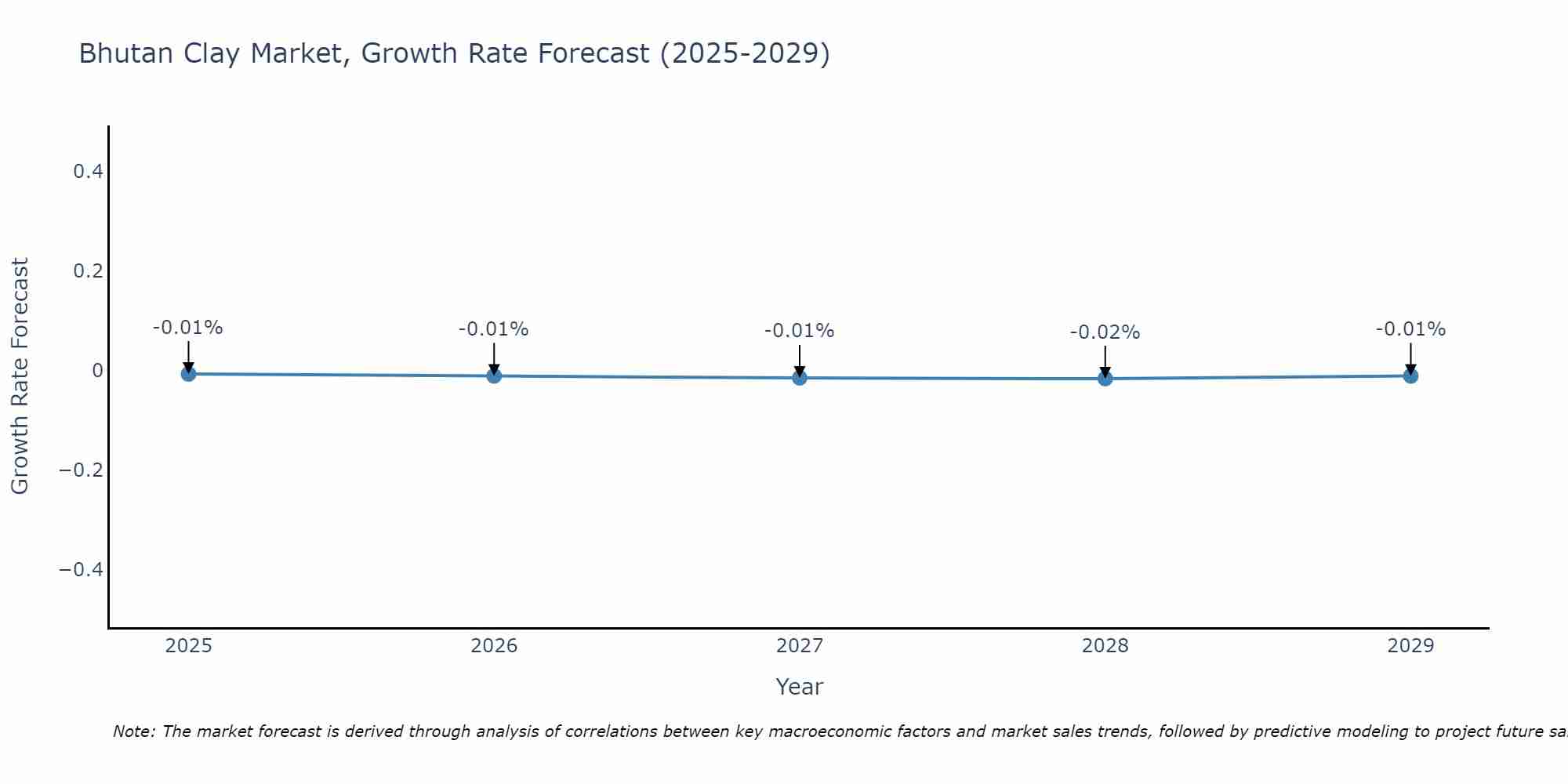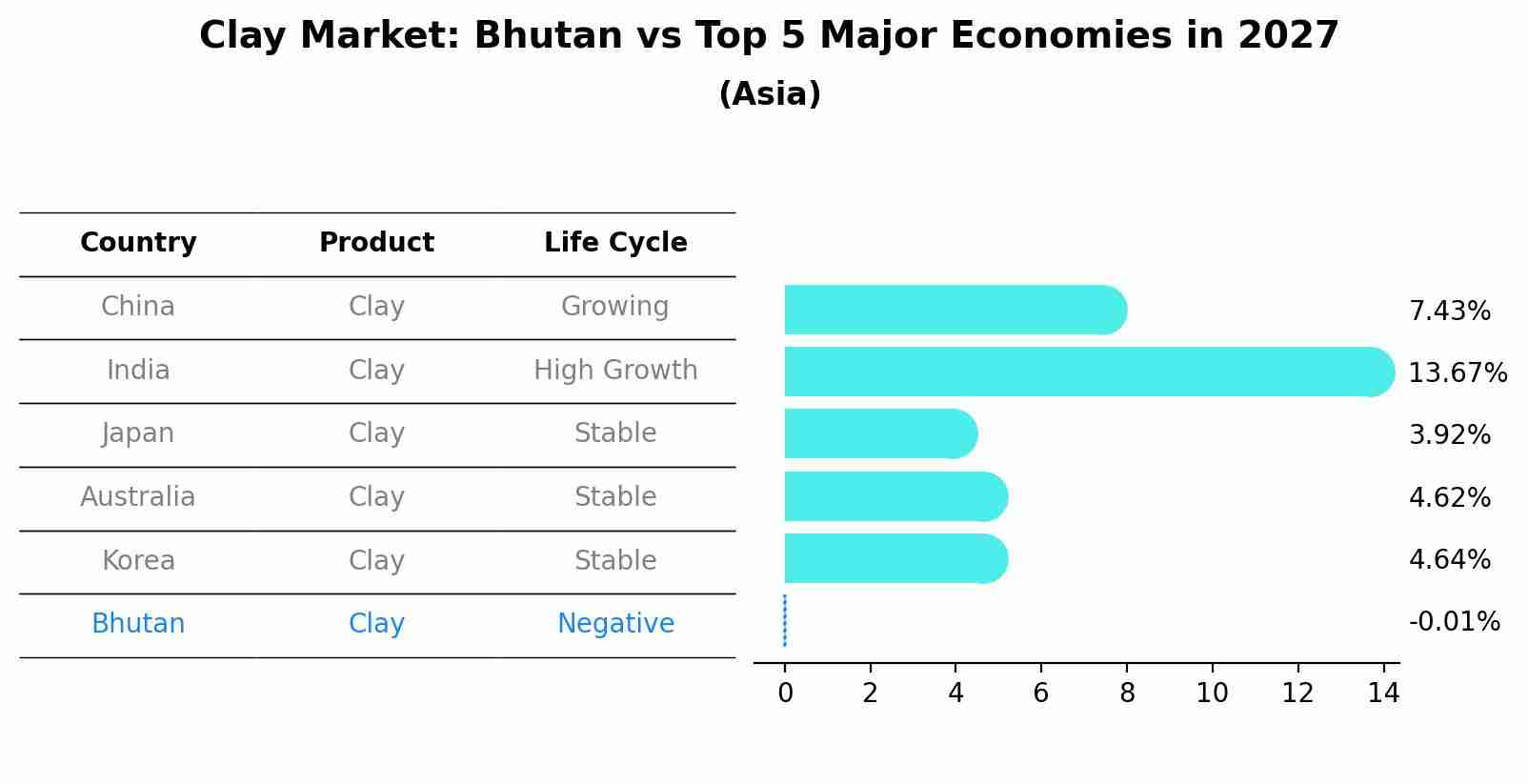Bhutan Clay Market (2025-2031) | Forecast, Share, Size, Industry, Companies, Value, Outlook, Analysis, Revenue, Trends, Segmentation & Growth
| Product Code: ETC5257629 | Publication Date: Nov 2023 | Updated Date: Sep 2025 | Product Type: Market Research Report | |
| Publisher: 6Wresearch | Author: Bhawna Singh | No. of Pages: 60 | No. of Figures: 30 | No. of Tables: 5 |
Bhutan Clay Market Size Growth Rate
The Bhutan Clay Market is projected to witness mixed growth rate patterns during 2025 to 2029. Starting high at -0.01% in 2025, the market steadily declines to -0.01% by 2029.

Clay Market: Bhutan vs Top 5 Major Economies in 2027 (Asia)
In the Asia region, the Clay market in Bhutan is projected to expand at a negative growth rate of -0.01% by 2027. The largest economy is China, followed by India, Japan, Australia and South Korea.

Bhutan Clay Market Overview
The clay market in Bhutan encompasses various types of clay used in industries such as ceramics, construction, and agriculture. Clay is a versatile material with applications ranging from pottery and bricks to soil conditioning. The market is influenced by factors such as construction activity, demand for traditional crafts, and agricultural practices. Challenges include environmental regulations and the availability of high-quality clay deposits.
Drivers of the market
The Bhutan clay market is driven by the growing demand for clay-based products in construction, ceramics, and agriculture. As Bhutan`s infrastructure development progresses, the need for clay for brick production and other construction materials increases. The popularity of ceramic arts and traditional crafts also supports the demand for clay. Additionally, clay is used in agriculture for soil improvement and water retention, which further drives its demand. The market benefits from both traditional uses and emerging applications, contributing to its overall growth.
Challenges of the market
The clay market in Bhutan is challenged by limited local mining and production capabilities. The countrys geological conditions and the scale of mining operations affect the availability and quality of clay. Additionally, the market faces competition from imported clays, which can be more cost-effective due to economies of scale. There is also a need for better infrastructure and technology to support local clay processing and manufacturing, as well as efforts to increase awareness of the benefits and uses of Bhutanese clay.
Government Policy of the market
The clay market in Bhutan is guided by policies that promote the use of locally sourced raw materials for construction and manufacturing. Government initiatives support the mining and processing of clay for various applications, including pottery, construction materials, and ceramics. Regulations are in place to ensure sustainable mining practices and the quality of clay products. The Bhutan Geological Survey and Mines Department oversees these regulations to balance economic development with environmental protection.
Key Highlights of the Report:
- Bhutan Clay Market Outlook
- Market Size of Bhutan Clay Market, 2024
- Forecast of Bhutan Clay Market, 2031
- Historical Data and Forecast of Bhutan Clay Revenues & Volume for the Period 2021-2031
- Bhutan Clay Market Trend Evolution
- Bhutan Clay Market Drivers and Challenges
- Bhutan Clay Price Trends
- Bhutan Clay Porter`s Five Forces
- Bhutan Clay Industry Life Cycle
- Historical Data and Forecast of Bhutan Clay Market Revenues & Volume By Application for the Period 2021-2031
- Historical Data and Forecast of Bhutan Clay Market Revenues & Volume By Tableware for the Period 2021-2031
- Historical Data and Forecast of Bhutan Clay Market Revenues & Volume By Sanitary ware for the Period 2021-2031
- Historical Data and Forecast of Bhutan Clay Market Revenues & Volume By Medical applications for the Period 2021-2031
- Historical Data and Forecast of Bhutan Clay Market Revenues & Volume By End Use for the Period 2021-2031
- Historical Data and Forecast of Bhutan Clay Market Revenues & Volume By Ceramic and for the Period 2021-2031
- Historical Data and Forecast of Bhutan Clay Market Revenues & Volume By Non-ceramic for the Period 2021-2031
- Bhutan Clay Import Export Trade Statistics
- Market Opportunity Assessment By Application
- Market Opportunity Assessment By End Use
- Bhutan Clay Top Companies Market Share
- Bhutan Clay Competitive Benchmarking By Technical and Operational Parameters
- Bhutan Clay Company Profiles
- Bhutan Clay Key Strategic Recommendations
Frequently Asked Questions About the Market Study (FAQs):
1 Executive Summary |
2 Introduction |
2.1 Key Highlights of the Report |
2.2 Report Description |
2.3 Market Scope & Segmentation |
2.4 Research Methodology |
2.5 Assumptions |
3 Bhutan Clay Market Overview |
3.1 Bhutan Country Macro Economic Indicators |
3.2 Bhutan Clay Market Revenues & Volume, 2021 & 2031F |
3.3 Bhutan Clay Market - Industry Life Cycle |
3.4 Bhutan Clay Market - Porter's Five Forces |
3.5 Bhutan Clay Market Revenues & Volume Share, By Application, 2021 & 2031F |
3.6 Bhutan Clay Market Revenues & Volume Share, By End Use, 2021 & 2031F |
4 Bhutan Clay Market Dynamics |
4.1 Impact Analysis |
4.2 Market Drivers |
4.2.1 Increasing demand for eco-friendly and sustainable building materials |
4.2.2 Growing awareness about the benefits of using clay in construction |
4.2.3 Government initiatives promoting the use of locally sourced materials |
4.3 Market Restraints |
4.3.1 Limited availability and access to high-quality clay deposits |
4.3.2 Lack of technological advancements in clay processing techniques |
4.3.3 Competition from alternative building materials like concrete and steel |
5 Bhutan Clay Market Trends |
6 Bhutan Clay Market Segmentations |
6.1 Bhutan Clay Market, By Application |
6.1.1 Overview and Analysis |
6.1.2 Bhutan Clay Market Revenues & Volume, By Tableware, 2021-2031F |
6.1.3 Bhutan Clay Market Revenues & Volume, By Sanitary ware, 2021-2031F |
6.1.4 Bhutan Clay Market Revenues & Volume, By Medical applications, 2021-2031F |
6.2 Bhutan Clay Market, By End Use |
6.2.1 Overview and Analysis |
6.2.2 Bhutan Clay Market Revenues & Volume, By Ceramic and, 2021-2031F |
6.2.3 Bhutan Clay Market Revenues & Volume, By Non-ceramic, 2021-2031F |
7 Bhutan Clay Market Import-Export Trade Statistics |
7.1 Bhutan Clay Market Export to Major Countries |
7.2 Bhutan Clay Market Imports from Major Countries |
8 Bhutan Clay Market Key Performance Indicators |
8.1 Percentage increase in the number of construction projects using clay as a primary material |
8.2 Average price of clay products in the market |
8.3 Number of training programs or workshops conducted to educate builders and architects on the benefits of using clay |
9 Bhutan Clay Market - Opportunity Assessment |
9.1 Bhutan Clay Market Opportunity Assessment, By Application, 2021 & 2031F |
9.2 Bhutan Clay Market Opportunity Assessment, By End Use, 2021 & 2031F |
10 Bhutan Clay Market - Competitive Landscape |
10.1 Bhutan Clay Market Revenue Share, By Companies, 2024 |
10.2 Bhutan Clay Market Competitive Benchmarking, By Operating and Technical Parameters |
11 Company Profiles |
12 Recommendations | 13 Disclaimer |
- Single User License$ 1,995
- Department License$ 2,400
- Site License$ 3,120
- Global License$ 3,795
Search
Related Reports
- ASEAN and Thailand Brain Health Supplements Market (2025-2031) | Strategy, Consumer Insights, Analysis, Investment Trends, Opportunities, Growth, Size, Share, Industry, Revenue, Segments, Value, Segmentation, Supply, Forecast, Restraints, Outlook, Competition, Drivers, Trends, Demand, Pricing Analysis, Competitive, Strategic Insights, Companies, Challenges
- ASEAN Bearings Market (2025-2031) | Strategy, Consumer Insights, Analysis, Investment Trends, Opportunities, Growth, Size, Share, Industry, Revenue, Segments, Value, Segmentation, Supply, Forecast, Restraints, Outlook, Competition, Drivers, Trends, Demand, Pricing Analysis, Competitive, Strategic Insights, Companies, Challenges
- Europe Flooring Market (2025-2031) | Outlook, Share, Industry, Trends, Forecast, Companies, Revenue, Size, Analysis, Growth & Value
- Saudi Arabia Manlift Market (2025-2031) | Outlook, Size, Growth, Trends, Companies, Industry, Revenue, Value, Share, Forecast & Analysis
- Uganda Excavator, Crane, and Wheel Loaders Market (2025-2031) | Strategy, Consumer Insights, Analysis, Investment Trends, Opportunities, Growth, Size, Share, Industry, Revenue, Segments, Value, Segmentation, Supply, Forecast, Restraints, Outlook, Competition, Drivers, Trends, Demand, Pricing Analysis, Competitive, Strategic Insights, Companies, Challenges
- Rwanda Excavator, Crane, and Wheel Loaders Market (2025-2031) | Strategy, Consumer Insights, Analysis, Investment Trends, Opportunities, Growth, Size, Share, Industry, Revenue, Segments, Value, Segmentation, Supply, Forecast, Restraints, Outlook, Competition, Drivers, Trends, Demand, Pricing Analysis, Competitive, Strategic Insights, Companies, Challenges
- Kenya Excavator, Crane, and Wheel Loaders Market (2025-2031) | Strategy, Consumer Insights, Analysis, Investment Trends, Opportunities, Growth, Size, Share, Industry, Revenue, Segments, Value, Segmentation, Supply, Forecast, Restraints, Outlook, Competition, Drivers, Trends, Demand, Pricing Analysis, Competitive, Strategic Insights, Companies, Challenges
- Angola Excavator, Crane, and Wheel Loaders Market (2025-2031) | Strategy, Consumer Insights, Analysis, Investment Trends, Opportunities, Growth, Size, Share, Industry, Revenue, Segments, Value, Segmentation, Supply, Forecast, Restraints, Outlook, Competition, Drivers, Trends, Demand, Pricing Analysis, Competitive, Strategic Insights, Companies, Challenges
- Israel Intelligent Transport System Market (2025-2031) | Strategy, Consumer Insights, Analysis, Investment Trends, Opportunities, Growth, Size, Share, Industry, Revenue, Segments, Value, Segmentation, Supply, Forecast, Restraints, Outlook, Competition, Drivers, Trends, Demand, Pricing Analysis, Competitive, Strategic Insights, Companies, Challenges
- Uganda Precast and Aggregate Market (2025-2031) | Strategy, Consumer Insights, Analysis, Investment Trends, Opportunities, Growth, Size, Share, Industry, Revenue, Segments, Value, Segmentation, Supply, Forecast, Restraints, Outlook, Competition, Drivers, Trends, Demand, Pricing Analysis, Competitive, Strategic Insights, Companies, Challenges
Industry Events and Analyst Meet
Our Clients
Whitepaper
- Middle East & Africa Commercial Security Market Click here to view more.
- Middle East & Africa Fire Safety Systems & Equipment Market Click here to view more.
- GCC Drone Market Click here to view more.
- Middle East Lighting Fixture Market Click here to view more.
- GCC Physical & Perimeter Security Market Click here to view more.
6WResearch In News
- Doha a strategic location for EV manufacturing hub: IPA Qatar
- Demand for luxury TVs surging in the GCC, says Samsung
- Empowering Growth: The Thriving Journey of Bangladesh’s Cable Industry
- Demand for luxury TVs surging in the GCC, says Samsung
- Video call with a traditional healer? Once unthinkable, it’s now common in South Africa
- Intelligent Buildings To Smooth GCC’s Path To Net Zero













